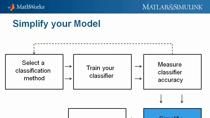머신러닝과 딥러닝 | 딥러닝 입문
시리즈: Introduction to Deep Learning
이 MATLAB® Tech Talk에서는 딥러닝과 머신러닝의 차이점에 대해 알아볼 수 있습니다. 몇몇 예제를 따라 해보고, 직접 활용해 볼 방법을 어떻게 정할지에 대해서도 알아볼 수 있습니다.
이 비디오에서는 머신러닝 문제를 해결하기 위한 구체적인 워크플로를 소개합니다.
이 비디오는 머신러닝과 딥러닝 간 서로 다른 요구사항에 대해서도 소개합니다. 여러분은 머신러닝과 딥러닝 중 무엇을 선택할지 결정하기 전에 꼭 물어야 할 핵심 질문에 대해 배우게 될 것입니다.
머신러닝과 딥러닝 중 어떤 것을 선택할지는 데이터와 해결하려는 문제에 따라 달라집니다. MATLAB은 이 두 기법을 모두 지원하며, 여러분은 필요에 따라 이들 기법을 개별적으로, 또는 함께 사용할 수도 있습니다.
MATLAB을 사용한 딥러닝에 대해 자세히 알아보세요.
녹화된 날짜: 2017년 3월 24일
Deep learning and machine learning both offer ways to train models and classify data. This video compares the two, and it offers ways to help you decide which one to use. Let's start by discussing the classic example of cats versus dogs. Now, in this picture, do you see a cat or a dog? How are you able to answer that? Chances are you've seen many cats and dogs over time, and so you've learned how to identify them. This is essentially what we're trying to get a computer to do: learn from and recognize examples.
Also keep in mind that sometimes even humans can get identification wrong, so we might expect a computer to make similar errors. To have a computer do classification using a standard machine learning approach, we'd manually select the relevant features of an image, such as edges or corners, in order to train the machine learning model. The model then references those features when analyzing and classifying new objects.
This is an example of object recognition. However, these techniques can also be used for scene recognition and object detection. When solving a machine learning problem, you follow a specific workflow. You start with an image, and then you extract relevant features from it. Then you create a model that describes or predicts the object. On the other hand, with deep learning, you skip the manual step of extracting features from images. Instead, you feed images directly into the deep learning algorithm, which then predicts the object.
So deep learning is a subtype of machine learning. It deals directly with images and is often more complex. For the rest of the video, when I mention machine learning, I mean anything not in the deep learning category. When choosing between machine learning and deep learning, you should ask yourself whether you have a high-performance GPU and lots of labeled data.
If you don't have either of these things, you'll have better luck using machine learning over deep learning. This is because deep learning is generally more complex, so you'll need at least a few thousand images to get reliable results. You'll also need a high-performance GPU so the model spends less time analyzing those images. If you choose machine learning, you have the option to train your model on many different classifiers. You may also know which features to extract that will produce the best results.
Plus, with machine learning, you have the flexibility to choose a combination of approaches. Use different classifiers and features to see which arrangement works best for your data. You can use MATLAB to try these combinations quickly. Also keep in mind that if you are looking to do things like face detection, you can use out-of-the-box MATLAB examples.
As we mentioned before, you need less data with machine learning than with deep learning, and you can get to a trained model faster too. However, deep learning has become very popular recently because it is highly accurate. You don't have to understand which features are the best representation of the object. These are learned for you. But in a deep learning model, you need a large amount of data, which means the model can take a long time to train.
You are also responsible for many of the parameters, and because the model is a black box, if something isn't working correctly, it may be hard to debug.
So, in summary, the choice between machine learning and deep learning depends on your data and the problem you're trying to solve. MATLAB can help you with both of these techniques, either separately or as a combined approach. To find out more, visit mathworks.com/deep-learning.





